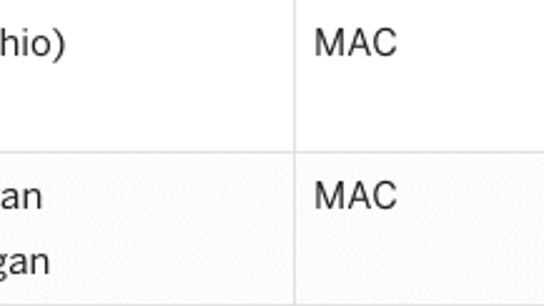The Mountain West has been open about the possibility of cord-cutting in the future. But maybe they're not the only league that should consider it.
Bowling Green hosted Toledo last night. It was televised on ESPNU. Wednesday night football. #MACtion. What could be better?
Well, here's how the Toledo Blade's column from the game opens:
BOWLING GREEN — The 82nd installment of the Toledo-Bowling Green rivalry featured all the usual trappings of MACtion.
Bands playing. Points flying. Hot cocoa — and $7 Miller Lites — flowing. The only thing missing? Anyone watching.
Remember Wednesday and the Rockets’ 66-37 beatdown for the bone-chilled night the Mid-American Conference’s television deal officially jumped the shark.
Fans surrounded by more than a few empty seats watch Toledo and Bowling Green play Wednesday at Doyt Perry Stadium.
I’m not sure which was worse: the two-thirds empty Doyt Perry Stadium or a TV audience less than that of an overnight airing of Happy Days.
Sure, it didn't help that the home team lost the game 66-37, but a mostly-empty stadium is baked into the #MACtion experience.
The Mountain West has a similar issue, just on a different spot on the calendar. Rather than asking their fans to show up on a Wednesday night, Mountain West fans are asked to attend games that start at or after 8 p.m. local time on Saturday nights, and thereby make the trek home from the (often remote) stadium around midnight -- and driving through the middle of the night through the Rocky Mountains at this time of year can often be a dangerous journey.
There are two rebuttals to this:
1) We need the exposure
2) We need the money
But how much exposure are these schools really getting?
Here's a sampling of viewing audiences for MAC and MW games, via Sports Media Watch. Viewership is in the second column.

Notice all four of those games are on ESPN2. Audiences for games on ESPNU and CBS Sports Network are likely even smaller than these.
As for the money, yeah, it's important. Each MAC and MW school earns about $1 million per year from its respective media rights deals. No, it's not even close to Power 5 money, but it's money these schools need and it's money they'd have trouble making up elsewhere. "It would be very difficult for us to give up the TV money and make it up in ticket sales," Boise State AD Curt Aspey told ESPN.
But what is the opportunity cost of playing when the networks tell you to play? Sure, the leagues get on ESPN. But what does that mean?
Mountain West commissioner Craig Thompson broke that down in real terms to ESPN:
"It's not priceless, but what is the value of a national television game for recruiting purposes? The national exposure that those games generate is worth something. They're in roughly a quarter of a million homes. What does that mean? Is that one replacement running back that you desperately need that lives in Georgia watching that game and going, 'Oh yeah, I'm going to one of those Mountain West schools. I love their style of play. I don't know. What are we missing? What are we gaining?"
Would it be easier to get recruits on campus for games on Saturday afternoons?
Sure, it would hurt to give away guaranteed money, but would an AD have an easier time fundraising if fans could get home at a reasonable hour on Saturday night? And would recruits be more willing to commit if they visited for a game where half the fans didn't leave at halftime?
Administrators from the Mountain West are asking themselves these questions. MAC presidents and ADs should probably do the same.
